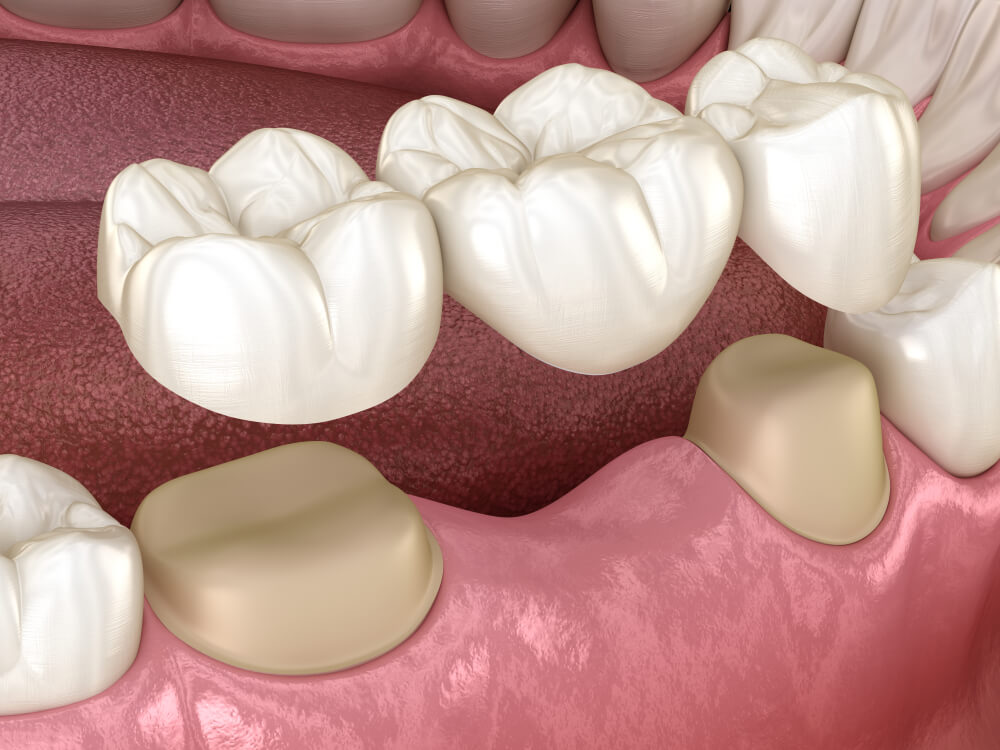Dental crowns are tooth-shaped caps placed over the natural tooth in order to restore teeth with moderate to severe damage or decay. When multiple dental crowns are fused together, along with one or more fake teeth, then this is known as a dental bridge. Dental bridges are used to fill in the gaps left by missing teeth, while also restoring the surrounding teeth.
Did You Know?
Each tooth has a crown, neck, and root. The crown is the only visible portion of the tooth, while the neck and roots are below the gum line, although the neck can sometimes be visible if the gums recede. Dental crowns earned their name because they fit over the “crown” of the tooth, while dental bridges earned their name because they “bridge” the gap between two natural teeth.
Frequently Asked Questions:
Am I a candidate for a dental crown or bridge?
Crowns and bridges are two different types of dental restorations that offer different options, which means you will often be a candidate for either one or the other. Candidates for a dental crown are individuals who have one or more teeth that are moderately to severely damaged or decayed. In cases where the decayed or damaged tissue cannot be restored with a filling, inlay, or onlay, then a crown is usually recommended.
Candidates for a dental bridge are individuals who have one or more missing teeth surrounded by generally healthy teeth on either side of the gap. You may also be a candidate for a dental bridge if you have one or more teeth that are in need of an extraction and are looking for a tooth replacement option. To determine if you are an ideal candidate for a dental crown or bridge, schedule a consultation with Maxtown Family Dental today.
What types of dental crowns and bridges are available?
Although all dental crowns are customized to fit each individual, they can be made out of different dental materials, including:
- Stainless steel
- Metal
- Porcelain fused to metal (PFM)
- Porcelain
- Resin
Nowadays, porcelain crowns are generally used since they are both aesthetic and durable. However, there still may be cases where another dental material is recommended. Dental bridges are also fabricated from different materials and are customized to fit each individual. However, there are different types of dental bridges that are defined by their structure. These include:
- Traditional: a traditional bridge contains one or more fake teeth surrounded by a dental crown on either side. Once the crowns are mounted on the surrounding teeth, this is what supports the bridge.
- Cantilever: instead of having a crown on both sides, Cantilever bridges only have one crown fused to a single fake tooth.
- Maryland Bonded: instead of supporting the bridge with dental crowns on either side, a Maryland Bonded bridge is supported by a metal framework bonded to the back of remaining teeth.
- Implant-supported: supported by dental implants in the jaw rather than traditional dental crowns.
What should I expect when having a crown or bridge placed at Maxtown Family Dental?
At Maxtown Family Dental, having a crown or bridge placed requires two dental appointments. During the first appointment, the affected tooth will be numbed so that the decayed or damaged tissue can be removed. The tooth will then need to be reshaped so that a dental crown can fit over the top without changing your bite. Oftentimes, this means that your tooth will be reduced in size. After the tooth has been prepared, a dental impression or oral scan is taken and sent to a dental laboratory.
Since it will take around 1-2 week for the lab to fabricate your permanent restoration, you will be fit with a temporary crown. This temporary crown will be removed once your permanent crown has arrived. Then your permanent crown will be fitted, adjusted as necessary, and cemented in place. This process is similar for having a dental bridge placed, however two teeth will be fit for crowns.
What can I expect after having a crown or bridge placed?
After having your temporary crown or bridge placed, you will want to temporarily avoid chewing on that side of your mouth. It is also recommended to avoid chewing anything too hard, crunchy, sticky, or chewy in order to prevent dislodging the temporary restoration. This is because your temporary bridge or crown is not nearly as strong as your permanent crown or bridge, and is more susceptible to being damaged or falling out.
Once you have your permanent restoration, you can return to your usual diet and habits. However, you will still want to exercise caution when eating excessively hard, crunchy, chewy, or sticky foods to prevent the restoration from becoming damaged. To care for your crown or bridge, be sure to brush twice a day, floss daily, and visit Maxtown Family Dental every six months for a dental cleaning. When properly cared for, your crown or bridge should last around 10-15 years, depending on its material.




